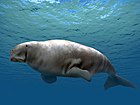Sobrarbesiren
| Sobrarbesiren Temporal range:
| |
|---|---|

| |
| Skeletal reconstruction of Sobrarbesiren, showing known elements in grey | |
| Scientific classification | |
| Domain: | Eukaryota |
| Kingdom: | Animalia |
| Phylum: | Chordata |
| Class: | Mammalia |
| Order: | Sirenia |
| Family: | incertae sedis |
| Genus: | †Sobrarbesiren |
| Species: | †S. cardieli
|
| Binomial name | |
| †Sobrarbesiren cardieli Díaz-Berenguer, 2018[1]
| |
Sobrarbesiren (meaning "siren from Sobrarbe") is a genus of extinct sirenian that lived in the Eocene, about 47 million years ago. The type and only species is S. cardieli, known from a multitude of specimens from the Spanish Pyrenees. Sobrarbesiren was a medium-sized animal, 2.7 m (8 ft 10 in) long and still retaining both pairs of limbs. Although initially thought to be amphibious, later studies instead suggest that they would have been fully aquatic and been selective sea grass browsers. Unlike modern dugongs and manatees, they likely lacked a tail fluke, although it would have appeared horizontally flattened.
Discovery and naming

Sobrarbesiren was discovered in the Castejón de Sobrarbe-41 locality (
The name Sobrarbesiren derives from the type locality, while the species name is a patronym, styled after Jesús Cardiel Lalueza who first discovered the site.[1]
Description

Sobrarbesiren was a medium-sized sirenian that retained all four limbs in a well developed state, unlike later sirenians that would eventually lose their hindlimbs entirely. Estimates suggest that it reached a length of 2.7 m (8 ft 10 in).[1]
The rostrum shows a significant downturn of 32°, which is notably more deflected than in prorastomids, but far from as developed as the deflection in later sirenians. The symphysis of the
The upper jaw of Sobrarbesiren preserved two

The vertebral column is only incompletely known, but the preserved neural spines do not show the same horizontal projections of prorastomid sirenians, nor the split neural spine seen in protosirenids. The atlas is wide and relatively shallow, while the axis is robust with a swollen neural spine. The genus' neural canal is teardrop-shaped, a condition similar to derived sirenians, while the neural spines themselves are much higher than in dugongids, which indicates the presence of ligament that may have supported the head. The vertebrae of the sacram, of which there are at least two (compared to one in protosirenids and dugongids), are unfused with short transverse processes. The caudal vertebrae are not well enough preserved nor is that part of the skeleton complete enough to determine whether or not Sobrarbesiren had a tail fluke, however it was likely horizontally flattened. The ribs are thick and dense (pachyosteosclerotic) as well as flat and broad.[1]
The
Phylogeny
Phylogenetic analysis conducted by Díaz-Berenguer and colleagues recovered Sobrarbesiren as a basal sirenian just outside of Dugongidae and more derived than prorastomids (which were found to be
| Sirenia |
| ||||||||||||||||||||||||
A later analysis made greater use of the neurocranial anatomy of Sobrarbesiren, both utilizing previously known specimens as well as newly discovered remains. Use of these features helped better resolve basal members of Sirenia. Under implied weighting, one of their analysis recovered Sobrarbesiren as a member of a new clade including Prototherium and Eotheroides, which nests in a position more basal than protosirenids, unlike in prior studies. However the authors hesitate to name the new clade, as they found poor support for this grouping, with another of their analyses instead finding the genus to nest in a large polytomy.[2]
| Pan-Sirenia |
| ||||||||||||||||||||||||
Paleobiology
Locomotion

Several characteristics of Sobrarbesiren have initially been used to suggest that it was still capable of supporting its own weight on land and could have moved quadrupedally. The tall neural spines could have helped keep the head upright while the pubis and sacroiliac joints would have made quadrupedal locomotion possible. It was initially argued that this differentiated Sobrarbesiren from the protosirenids, which were likely incapable of supporting themselves and were restricted to movement more like that of modern
However, a later paper by Díaz-Berenguer examined the hindlimbs and pelvis of Sobrarbesiren closer, comparing them to those of other basal sirenians, archaeocete whales and conducting microanatomical analysis on them. Their research concluded that the hips would have allowed for a wide variety of hindlimb movements while the sacral vertebrae allowed for lateral movement. The authors suggest that while swimming it could have moved by undulating its pelvis up and down while additionally paddling with its feet, similar to river otters. It is also possible that the hindlimbs of Sobrarbesiren complimented the flattened tail in its movement, as indicated by a torsion found on the femur. However, unlike the original description of the taxa, here the authors doubt that the animal would have been able to effectively move on land. They point towards the advanced osteosclerosis of the innominate and femur, which is much greater than what is seen in pinnipeds and more similar to what is known from protocetid whales. This could have rendered the bones too brittle to be used for terrestrial locomotion. They conclude that the internal changes of the bone would have preceded the external adaptations, explaining why they superficially appear sufficient enough for use out of water. Despite this, they note that the range of motion still suggests that the animal actively used its feet for swimming. [3]
Diet and environment
The degree to which the rostrums of sirenians deflect varies between genera and is generally connected to their diet. This is a particular adaptation to feeding on aquatic plants on the seafloor, with some of the most extreme cases displaying a downturn of up to 70°, like in the seagrass-specialized dugongs. The downturn of Sobrarbesiren is with 32° within the range of modern
The Castejón de Sobrarbe-41 locality is thought to have been a channel within the tidal zone of the




